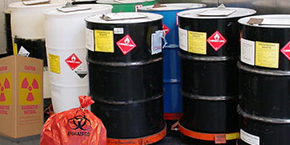Last week hazardous waste handler US Ecology (ECOL:
Nasdaq) reported $8.0 million in net income or
$0.36 per share on $131 million in total sales in the first quarter ending
March 2019. The results were in-line
with expectations for earnings per share of $0.32 on $130 million in
revenue. While business from clean-up
events continues sluggish, commercial and industries waste disposal services is
thriving.
The company usually converts about 20% of its sales to
operating cash flow, making it possible to internally finance capital
investments. In this recent quarter the
conversion rate slipped to 14%.
Nonetheless, the quarter results gave management the confidence to
reiterate guidance for the year 2019.
 |
| Industrial Hazardous Waste |
US Ecology stays in business because industrial processes
are rampant hazardous waste generators.
For example, laboratories must dispose of spent solvents and reagents
left over from testing. The textile industry
generates alkali and sodium hydroxide as a part of the mercerizing
process. These wastes must be treated
and collected by hazardous waste handlers like US Ecology for shipment to
approved facilities.
The U.S. Environmental Protection Agency (EPA) provides a
list of hundreds of waste materials that come about in
the course of common place processes. Metals
mining and chemical manufacturing industries figure prominently in the waste
streams handled by US Ecology.
One US Ecology’s strengths is its network of
transportation and disposal facilities.
The company can collect and transport waste to the most cost effective
disposal site, including landfills, deep wells or reservoirs using a mix of
trucks and railcar. The company can even
handle and store high-activity radium waste or low level radioactive waste.
 |
| River Raisin Clean Up |
Besides the day to day industrial flotsam and jetsam, US
Ecology handles hazardous waste cleaned up from industrial sites. While revenue from clean-up projects has been
down in recent quarters, in the past the company has turned a good coin
providing environmental remediation services.
One of the company’s most recent projects for which it has disclosed
data is the River Raisin in Michigan. US Ecology removed over 150,000 cubic yards
of contaminated sediment in from the river and restored more than 300 acres of
water habitat. The result was the return
of more than 20 miles of river area for fish reproduction.
Unfortunately, revenue streams from US Ecology’s event clean-up
business have been soft in recent periods.
Clean up projects often go into hiatus during the winter months and
those reliant on government funding can be held hostage to political
discrepancies. It is also a crowded
field and US Ecology has experienced intense price competition in bidding for
this work.
Continued sluggishness in revenue from event clean-up
projects may have been one of the reasons traders were disappointed in US
Ecology’s first quarter results. In the first day of trading following the
March quarter earnings announcement, traders fiercely trimmed back the share
price, causing the shares to dip into oversold territory. Some investors might see the price weakness
as a chance to again grab ECOL shares at compelling prices. After all humans and their businesses are not
likely to stop generating waste any time soon, guaranteeing US Ecology with
work for some time to come.
Neither the author of the Small Cap Strategist web
log, Crystal Equity Research nor its affiliates have a beneficial interest in
the companies mentioned herein.
No comments:
Post a Comment